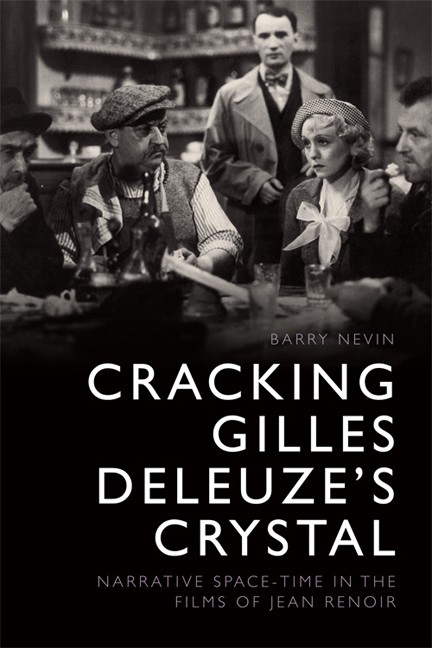Book contents
- Frontmatter
- Contents
- List of Figures
- Notes on Style
- Acknowledgements
- Preface
- Introduction
- 1 Theatrum Mundi: Framing Urban Dynamics in Renoir's Paris
- 2 From Desert to Dreamscape: Viewing Renoir's Rural Landscapes as Spatial Arenas
- 3 Portraying the Future(s) of the Front Populaire
- 4 Renoir's Crises Anti-Réalistes: Framing le Temps Gelé
- Conclusion
- Appendix: Corpus Breakdown
- Notes
- References
- Film Index
- General Subject Index
2 - From Desert to Dreamscape: Viewing Renoir's Rural Landscapes as Spatial Arenas
Published online by Cambridge University Press: 01 May 2021
- Frontmatter
- Contents
- List of Figures
- Notes on Style
- Acknowledgements
- Preface
- Introduction
- 1 Theatrum Mundi: Framing Urban Dynamics in Renoir's Paris
- 2 From Desert to Dreamscape: Viewing Renoir's Rural Landscapes as Spatial Arenas
- 3 Portraying the Future(s) of the Front Populaire
- 4 Renoir's Crises Anti-Réalistes: Framing le Temps Gelé
- Conclusion
- Appendix: Corpus Breakdown
- Notes
- References
- Film Index
- General Subject Index
Summary
Renoir's camera is another kind of explorer, one who hasn't gone ahead of us into the territory and can't presume to know exactly what to show us.
– Gilberto Perez, The Material GhostThis land, these fields play a role.
– Jean Renoir on The Southerner (1945)Introduction: Opening the Natural Landscape to Space-time
As noted in the introduction to Chapter 1, this book does not aim to dismiss the similar constitution of urban and rural space by assigning separate chapters to each. Since Raymond Williams's disintegration of the preconceived dichotomy between the country as ‘a natural way of life’ and the city as ‘an achieved centre’, E. Melanie DuPuis, Brian Short, and David Bell have also related illusory images of the rural idyll to a broad range of social factors including industrialisation, urbanisation, and bourgeois values.
Despite the similar theoretical and social grounding of rural and urban space, each merits separate analysis because of Renoir's repeated appropriation of each over the course of his career, representing a key exception to Susan Hayward's observation that ‘French films have focused on the city (in particular Paris) with landscape appearing as a mere dot on the French cinematic horizon.’ Natural landscapes provided Renoir with some of his core settings in the silent period, across the 1930s and also during his exile in Hollywood: La Fille de l’eau (1925) was filmed in Marlotte, his mother's homeplace; Le Bled (1929) was filmed in the Algerian desert; Toni (1935) is based on a farm in Martigues; Partie de campagne (1936) was filmed almost entirely outdoors at Champs-sur-Marne; La Règle du jeu (1939) was largely shot at la Sologne; The Southerner (1945) unfolds on a Texan plantation; The River (1951) was shot on location in India; and Le Déjeuner sur l’herbe (1959) was mostly filmed at Les Collettes, where Pierre-Auguste spent his final years. Even works that would be difficult to class as rural ‘landscape’ films reveal Renoir's penchant for natural settings: Boudu sauvé des eaux (1932) was partly filmed in the Bois de Boulogne and the outskirts of Paris; Swamp Water (1941) is set in Georgia's swamps; and much of the drama in Woman on the Beach (1947) is set on an unspecified American beach.
- Type
- Chapter
- Information
- Cracking Gilles Deleuze's CrystalNarrative Space-time in the Films of Jean Renoir, pp. 64 - 98Publisher: Edinburgh University PressPrint publication year: 2018



